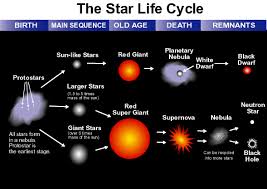What is the life cycle of a red giant star?
1 Answer
The star will begin to collapse and heat some more. The outer envelope expands causing the temperature to drop at the surface but also increasing surface area and thereby the luminosity of the star.
Explanation:
Small stars, like the Sun, will undergo a relatively peaceful and beautiful death that sees them pass through a planetary nebula phase to become a white dwarf.
Massive stars, on the other hand, will experience a most energetic and violent end, which will see their remains scattered about the cosmos in a enormous explosion, called a supernova.
Once the dust clears, the only thing remaining will be a rapidly spinning neutron stars, or possibly even a black hole.

http://www.schoolsobservatory.org.uk/astro/stars/lifecycle
See the referenced page also for the chart and other descriptions.
When the star has run out of hydrogen fuel to fuse into helium within its core the core will begin to collapse and heat some more. To counter the core's collapse the outer envelope expands causing the temperature to drop at the surface but also increasing surface area and thereby the luminosity of the star.
Within the core temperatures will rise to begin fusion of helium into carbon. A shell around the core will rise to such a temperature as to ignite further hydrogen fusion in that region of the star. The helium produced falls onto the core where it can be used as fuel. This time in the life of a Red Giant is very short compared to the main sequence lifetime, only a few million years.
http://cse.ssl.berkeley.edu/bmendez/ay10/2000/cycle/redgiant.html

